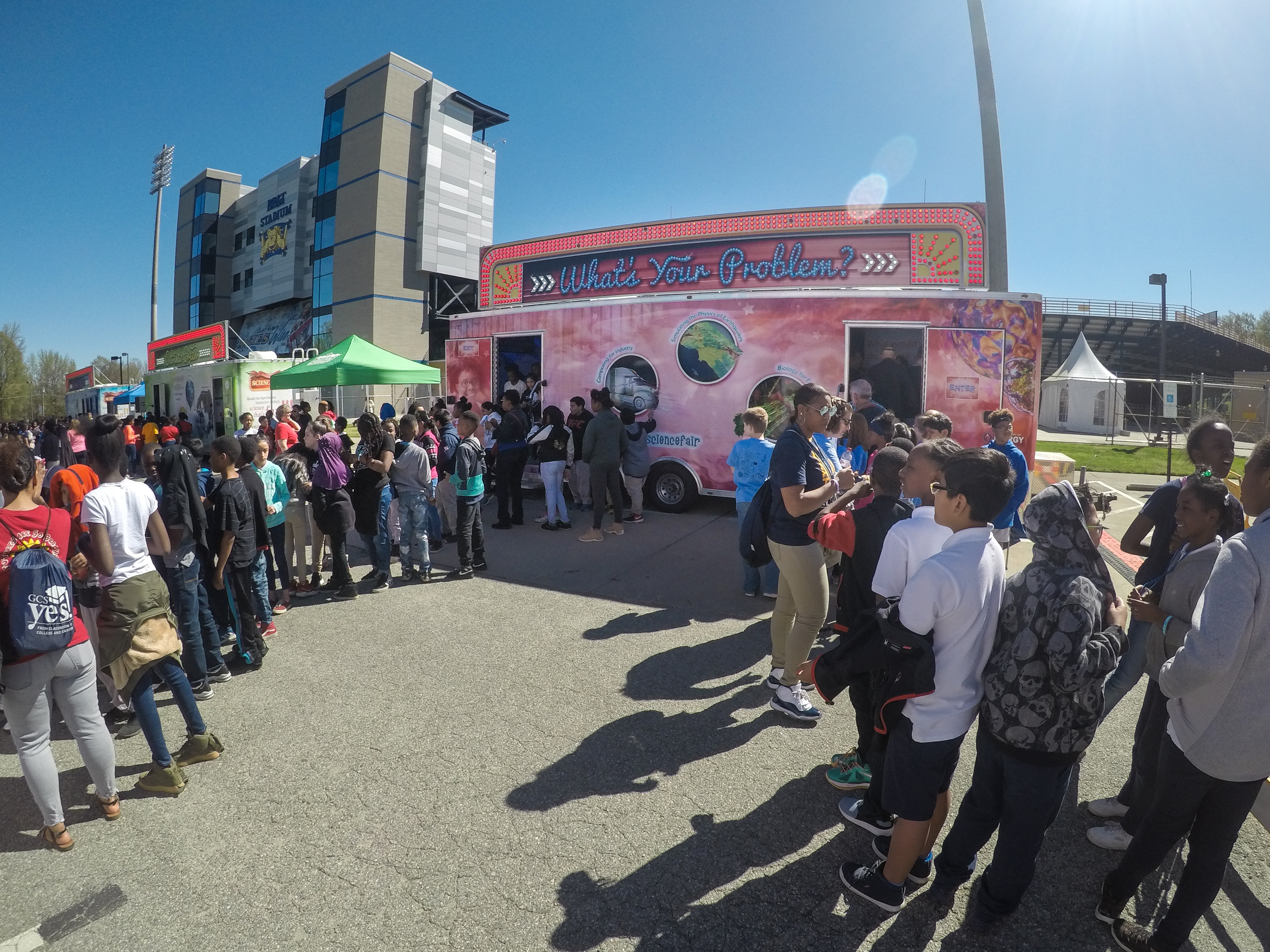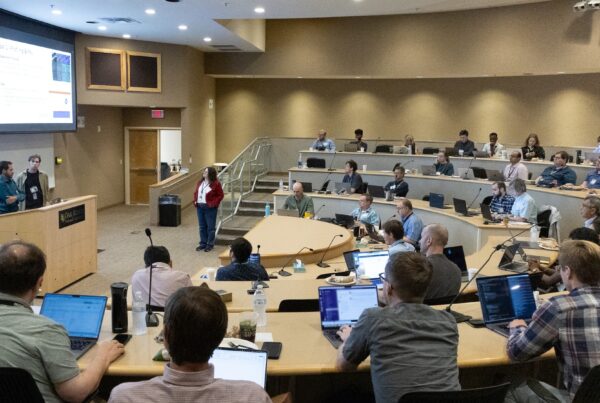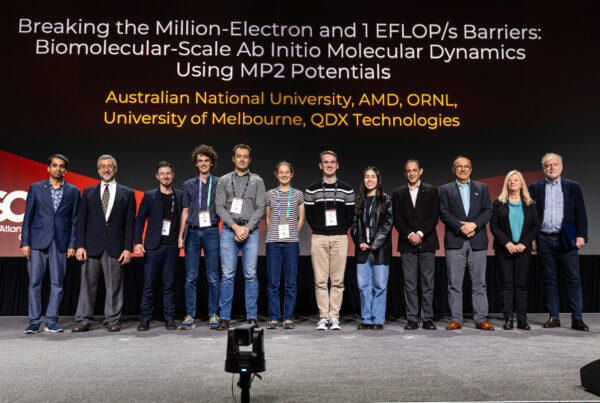“What’s Your Problem?” This question, emblazoned on the side of a bright red trailer, invites students of all ages to step into the world of computational science.
This mobile exhibit showcases the scientific and technological achievements made possible by past, present, and future supercomputers located at the US Department of Energy’s (DOE’s) Oak Ridge National Laboratory (ORNL). The computing trailer and its five counterparts—focused on neutron science, nanoscience, environmental science, nuclear science, and mission support—make up the ORNL Traveling Science Fair, an educational initiative designed to pique students’ interest in science, technology, engineering, and mathematics (STEM) by participating in local and national school events, career fairs, and science festivals.
A team of ORNL scientists and support staff recently designed and implemented more interactive components in the computing trailer to better represent different research areas and incorporate information about the lab’s newest system, the IBM AC922 Summit. The world’s fastest and smartest supercomputer, Summit resides at the Oak Ridge Leadership Computing Facility (OLCF), a DOE Office of Science User Facility located at ORNL.
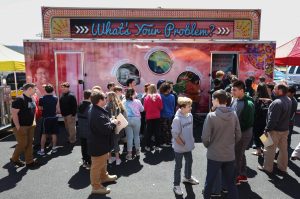
The updated computing trailer at an April 1 event in Sweetwater, Tennessee. Credit: Genevieve Martin, ORNL.
“Many people are aware of the work done at the lab with supercomputing, and they keep up with the machines we build,” said Jayson Hines, project manager for ORNL’s Computing and Computational Sciences Directorate. “A big reason we upgraded the trailer was because it just wouldn’t seem right without Summit.”
Returning favorites
As students enter the trailer, a series of mirrors surrounds them with their own reflections. Known as the infinity room, this area encourages participants to imagine how much faster they could complete chores, homework, and other daily tasks if all their reflections could work together. This visual representation helps explain how parallel computing enables supercomputers to complete many calculations at once.
“The mirrors are an analogy for how our supercomputers work—instead of relying on one processor, we connect thousands of them together to solve big science problems,” Hines said.
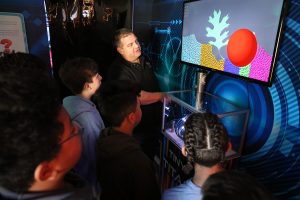
Tiny Titan demonstrates the power of parallel computing. Credit: Genevieve Martin, ORNL.
Following this introduction, students can operate Tiny Titan, a portable version of the Cray XK7 Titan supercomputer located at the OLCF. Using Xbox controllers, students can manipulate color-coded particles on a screen to increase the efficiency of a simple fluid dynamics code. They can gradually scale up the code from running on a single computer node to running on a total of nine nodes, demonstrating how Titan helps researchers effectively tackle science challenges.
“Tiny Titan has been a great tool that keeps young audiences engaged, and we hope the recently developed components spark plenty of interest as well,” Hines said.
New additions
Adjacent to Tiny Titan are three new touchscreen displays dedicated to other OLCF systems—the Cray X1E Phoenix, which demonstrates the value of vector processors; the Cray XT Jaguar, which shows the power of massively parallel systems; and Summit, which describes the benefits of a hybrid architecture containing both CPUs and GPUs.
These screens show students how technology has improved over time to support increasingly complex machines capable of reaching unprecedented speeds. Students can also review frequently asked questions and read about some of the most significant scientific results gleaned from simulations run on OLCF supercomputers.
“The new layout provides historical perspective for these machines and the science that’s been done at the OLCF since it became a user facility,” said OLCF computational scientist Bronson Messer. “There’s now a visual vocabulary of our technological advances over the past decade, so even a 10-year-old kid can see how dramatically things have changed just in his or her lifetime.”
Participants then proceed into the future room, an area that emphasizes the importance of artificial intelligence (AI), neuromorphic computing, and quantum computing—techniques likely to grow more prevalent as high-performance computing systems continue to evolve.
Neuromorphic computing, a type of AI, uses artificial neural networks that mimic biological activity in the human brain to enable machine learning algorithms capable of analyzing massive amounts of data. With the touch of a button, students can add and remove lines between different areas of a neural network graphic on the wall to illustrate how these algorithms make and break connections based on experience.
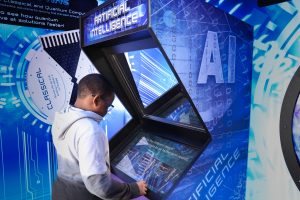
A student plays the AI game in front of the classical and quantum computing display. Credit: Genevieve Martin, ORNL.
Additionally, the future room contains a timed AI game that pits students against a computer to demonstrate how quickly machines can respond to stimuli. The timer begins when multiple images depicting an aisle of Summit appear onscreen, prompting students to select which one differs from the others in a matter of seconds.
“When there are only two pictures, it’s pretty easy to find that anomaly quickly, but the game will continue adding pictures until it’s nearly impossible to keep up with the computer,” Hines said.
The last stop in the trailer illustrates the difference between classical and quantum computing with an activity inspired by the game Plinko, in which tiny ball bearings travel through a maze of pegs to reach a destination. Classical computing involves information stored in bits of ones and zeroes. Quantum computing, however, uses qubits, which can contain ones, zeroes, or any combination of those two states, making it possible to store much more information.
Students turn two wheels to see this process in action. When they turn the classical computing wheel, the ball bearings travel slowly but surely through the maze to reach the bottom, whereas the quantum computing version unleashes a fast-moving avalanche of the ball bearings, covering the same distance and overcoming the same obstacles much faster.
“Classical computers are deterministic—you have one set of inputs and one set of outputs, and everything has to be expressed in those terms,” Messer said. “With quantum computing, you calculate all the different possibilities.”
Although these interactive elements can facilitate more self-guided tours through the trailer, staff volunteers are still present to provide explanations and answer questions. “Nothing beats being able to talk to a scientist in your field of interest,” Messer said.
The revamped trailer debuted this month at an event for Monroe County Schools in Sweetwater, Tennessee, followed by appearances at North Carolina A&T State University in Greensboro and the Catawba Science Center in Hickory, North Carolina.
“The new additions help us talk about technologies that show promise for the future, which may help scientists solve even bigger science problems in the years ahead,” Hines said.
UT-Battelle LLC manages Oak Ridge National Laboratory for DOE’s Office of Science, the single largest supporter of basic research in the physical sciences in the United States. DOE’s Office of Science is working to address some of the most pressing challenges of our time. For more information, please visit https://science.energy.gov.


